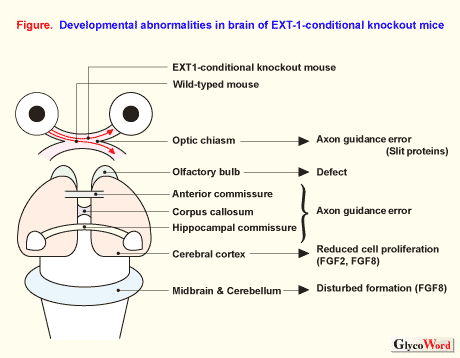

 |
 |
Role of Heparan Sulfate in the Development of the Central Nervous System |
||||||||||||||
 |
Discouraging results from heparan sulfate proteoglycan knockout mice It is known that heparan sulfate proteoglycans (HSPGs), which bind to axon guidance molecules, extracellular matrices, growth factors and cytokines via the heparan sulfate (HS) sugar chains, are involved in various developmental events (PG-A01). In Drosophila, mutations in genes for HSPGs or HS synthetic enzymes induce similar abnormalities observed in mutants for HS-binding molecules (1). Because it has been believed that HS or HSPG, abundantly expressed in developing central nervous tissues play pivotal roles in the development of the mammalian central nervous system via interaction with various HS-binding molecules, numerous knocked-out mice for genes encoding the core protein have been designed. However, so far no remarkable abnormality in the central nervous tissues of those HSPG-knockout mice has been reported (2). It is possible that even if a single HSPG gene is knocked out, the other HSPGs compensate because the expression patterns of HSPGs were similar to each other during central nervous system development. The other reason is that it may be necessary to delete HS rather than core proteins because HSPG-binding molecules bind to HS rather than core proteins. HS is essential to FGF function. Thus, in order to delete the gene for EXT1, an enzyme essential for HS synthesis, specifically from nervous tissue, we designed mice in which the genome for EXT1 was replaced by the loxP-modified EXT1 gene, then mated with Nestin-promoter Cre transgenic mice (3). The mutant mice, called EXT1-conditional knockout mice, died at birth because of severe abnormalities in central nervous tissues such as abnormal small cerebrum, defective olfactory bulbs and deformed cerebellum, which are closely similar to brain abnormalities in mutant mice for fibroblast growth factor-8 (FGF8), a HS-binding molecule. Also, the cerebellar abnormality in EXT1-conditional knockout mice resembles those in mutants for Wnt1 and Engrailed-1, downstream molecules on FGF8-signaling pathway in cerebellar development. Moreover, in EXT1-conditional knockout mice, the expression patterns of those downstream molecules are disturbed, indicating that HS is important for the localization of FGF8 and facilitates the proper expression pattern of downstream molecules. Additionally, cortical progenitor cells prepared from EXT1-conditional knockout embryos show markedly reduced FGF-induced cell proliferation. This means that disturbance of FGF-induced cell proliferation results in abnormal small cortex in EXT1-conditional knockout mice, suggesting that HS is essential to proper FGF physiologic function during the development of mammalian central nervous tissue. |
|||||||||||||
 |
||||||||||||||
|
|
||||||||||||||
|
HS is necessary for axon guidance.
Severe axon guidance errors in the corpus callosum, hippocampal commissure and anterior commissure were found in the EXT1-conditional knockout mice, indicating that HS is essential to axon guidance. Interestingly, while optic nerves in normal mice project to the contralateral superior colliculus after crossing the optic chiasm, most of the nerves in EXT1-conditional knockout mice project to the other eye abnormally. It was found that this abnormality reflects the involvement of HS with Slit proteins, which are HS-binding axon repulsive factors. All this taken together indicates that HS at least is necessary for the formation of the cerebellum and cerebral cortex and axon guidance in the mammalian central nervous system. |
||||||||||||||
| Masaru Inatani (Department of Ophthalmology, Osaka Red Cross Hospital) | ||||||||||||||
|
||||||||||||||
| Jan. 24, 2005 | ||||||||||||||
|
|
||||||||||||||
|
||||||||||||||